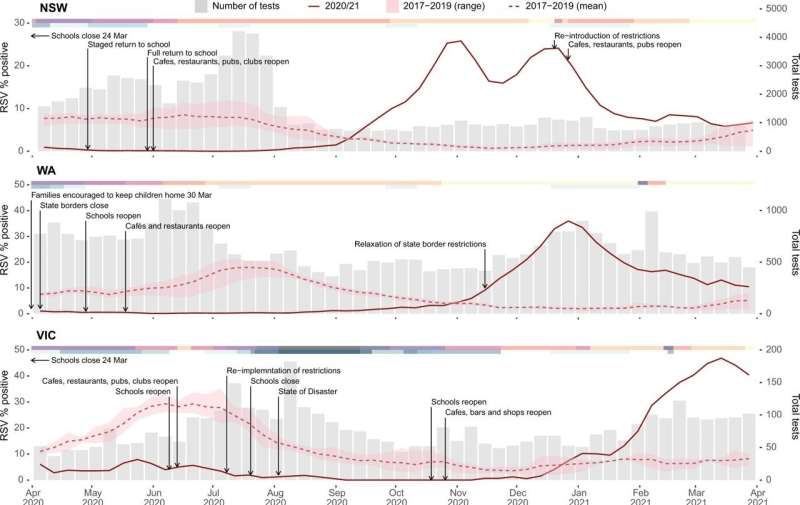The pandemic is changing the genetic landscape of virus strains

A University of Sydney led study reveals how the pandemic has changed the normal patterns of winter viruses in Australia, with new strains emerging and leaving most others "extinct." Researchers are warning of unexpected rebounds in the future.
One of the first studies to document the impact of COVID-19 on already existing viruses in Australia has revealed how the pandemic was responsible for creating a huge change in the incidence and genetics of Respiratory Syncytial Virus (RSV) in the country.
RSV is a common virus that generally causes mild, cold like symptoms, infection can be serious particularly for infants and older adults.
Researchers say the pandemic has disrupted the seasonal pattern of RSV, a key member of a group of regular "winter viruses." For the first time on record, during 2020, the winter RSV epidemic was absent due to COVID-19 travel restrictions and infection control measures.
However, RSV was one of the first of the key respiratory pathogens to re-emerge after COVID-19.
Published in Nature Communications, the researchers genetically sequenced (created and mapped genetic fingerprints of the virus) major outbreaks of RSV occurring out of season over the summer of 2020–21 on both sides of the country.
The outbreaks coincided with the easing of COVID-19 control measures.
A surprising finding was a major "collapse" in RSV strains already known before COVID-19, and the emergence of new RSV strains which dominated each outbreak in Western Australia, New South Wales and the Australian Capital Territory.
Importantly, the researchers then tracked the seeding of viruses from each outbreak into Victoria, which led to another major RSV outbreak.
"Our genetic studies showed that most of the previous RSV strains had gone 'extinct' and that for each outbreak only a single genetic lineage had survived all the lockdowns," said lead researcher Dr. John-Sebastian Eden, a Senior Research Fellow from the University of Sydney Institute for Infectious Diseases, Faculty of Medicine and Health, based at the Westmead Institute for Medical Research.
"We need to re-evaluate our current understanding and expectations of common viruses, including influenza, and change our approach to how we manage them."
The study also raises important questions as to how rapid spread and evolution of RSV could inform the re-emergence of other viruses including influenza.
"The constellation of flu strains circulating pre and post-COVID-19 has also changed a lot, leading to challenges in how we choose the composition and timing of our annual vaccines. For example, the flu season in Australia has kicked off much earlier than in previous years." said Dr. Eden
There is currently no RSV vaccine, but it's a major focus for vaccine and therapeutic development.
"We need to be vigilant—some viruses may have all but disappeared, but will likely rebound in the near future, possibly at unusual times and with stronger impact," said Dr. Eden.
"We need to be prepared for large outbreaks of RSV outside of normal seasonal periods and our health systems to be prepared."
Virus landscape in a state of change
The study documents a major shift in the epidemiology of RSV following the emergence of SARS-CoV-2, the virus responsible for COVID-19.
Not unlike contact tracers working to map virus spread in a community, the researchers mapped the circulation of viruses on a genetic level—termed as "genetic epidemiology."
The researchers genetically sequenced hundreds of RSV positive samples collected before and after the COVID-19 pandemic and used this data to create a genetic "family tree"—tracing the lineage of each virus strain.
Before COVID-19, two major RSV subtypes (A and B) co-circulated at similar levels.
During late 2020 to early 2021 during the outbreak periods, this changed dramatically. The RSV-A subtype was found to be the dominant strain—making up greater than 95% of cases in all the states. The RSV-B had all but disappeared.
"We found instead there were two new RSV strains, both RSV-A subtypes, and they were distinct in their geographic origin," said Dr. Eden.
"One was responsible for cases in NSW, ACT and VIC, and another responsible for cases in WA."
Dr. Eden said the COVID-19 pandemic had introduced unique circumstances shaping the virus's genetic landscape in Australia, and globally, with important consequences for how the genetic diversity of RSV will be restored.
As part of the evolutionary process, viruses naturally accumulate small genetic changes, just enough to make them distinct, but also possible to trace the changes back to their virus "parent," similar to a genetic family tree. These strains co-exist in the environment and is what causes genetic diversity.
The researchers found that the genetic diversity for RSV-A and RSV-B was extremely low but will likely be restored as international borders continue to open up.
More information: John-Sebastian Eden et al, Off-season RSV epidemics in Australia after easing of COVID-19 restrictions, Nature Communications (2022). DOI: 10.1038/s41467-022-30485-3
















